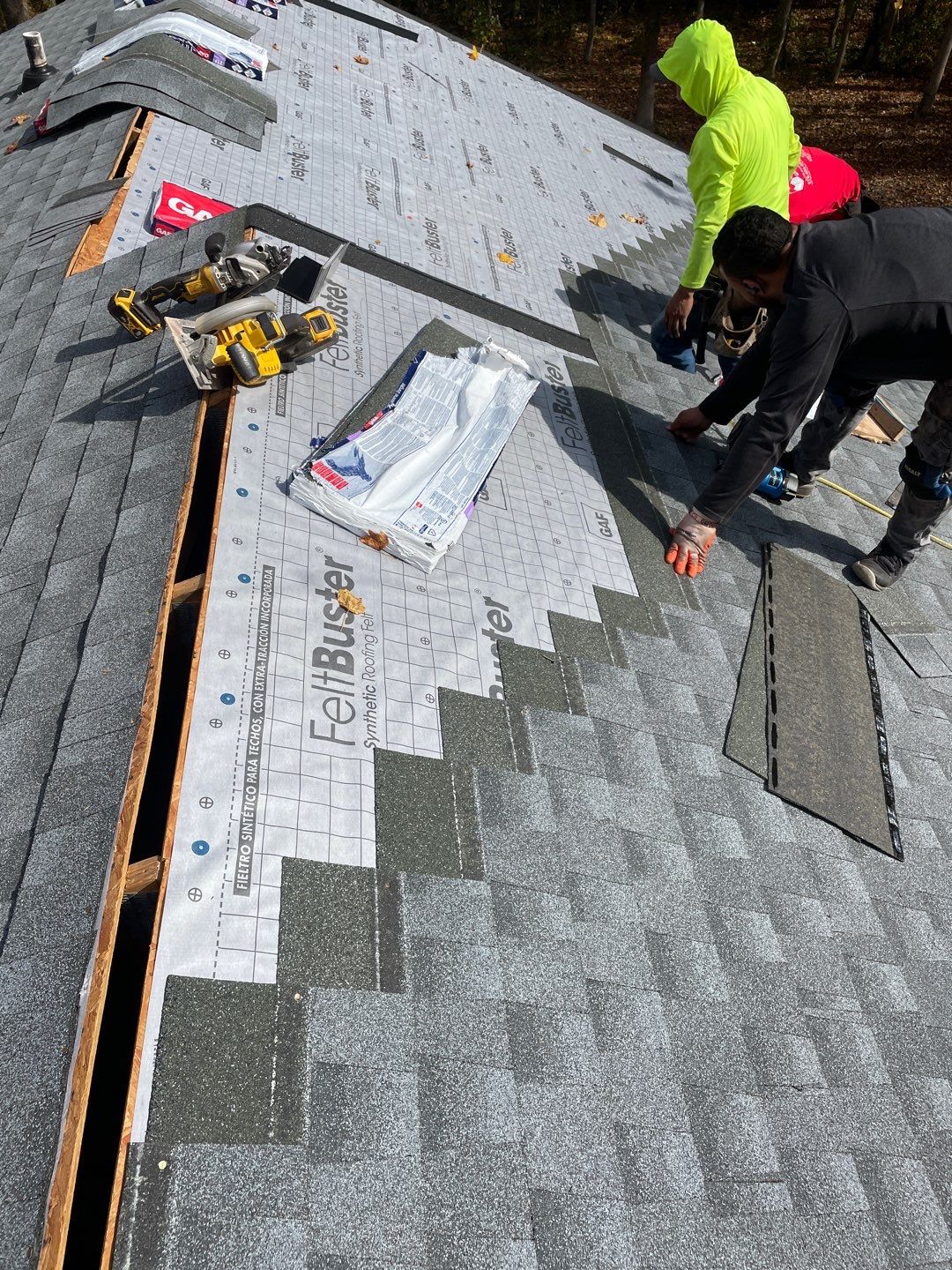The Relevance of Choosing Skilled Roofing Companies Gainesville Florida
Wiki Article
Finest Practices for Ensuring Appropriate Roofing Ventilation
Guaranteeing correct roof air flow is critical for the longevity and performance of a roof system. A balanced consumption and exhaust vent proportion, frequently 1:300, plays a crucial duty, with intake vents ideally placed at the lower edge of the roof for awesome air entrance and exhaust vents at the top for cozy air departure. Routine evaluations to identify blockages and keep clear air flow are extremely important. Maintaining insulation away from vents is vital to protect against airflow limitation. Understanding these fundamental aspects establishes the phase for even more in-depth understandings right into setup and upkeep practices that can considerably enhance your roof covering system's efficiency.Understand Air Flow Fundamentals
Effectively recognizing air flow basics is important for ensuring the durability and performance of roof covering systems. Reliable air flow alleviates wetness build-up and temperature level extremes in the attic room, both of which can cause substantial architectural damage in time. A well-ventilated roof covering assists in stopping typical problems such as mold development, wood rot, and ice dams, which can endanger the stability of the roof materials and the underlying frameworks.The main objective of air flow is to help with the motion of air, enabling a regular exchange in between the interior and outdoor atmospheres. This equilibrium is attained with a mix of intake and exhaust vents that collaborate to maintain ideal air flow. Consumption vents, commonly located along the soffits or eaves, permit fresh air to enter the attic room space, while exhaust vents, commonly situated at or near the roof covering ridge, allow hot, moist air to get away.
Trick elements influencing the performance of roof air flow include appropriate placement, sufficient sizing, and ensuring that both intake and exhaust vents are unhampered. Regular assessment and upkeep are crucial to identify prospective clogs, damage, or inadequacies in the air flow system, thus protecting the roofing system's efficiency and durability.
Types of Roof Covering Vents
Roofing vents play an important duty in preserving efficient attic room air flow and, by expansion, the overall health and wellness of the roof. Various types of roofing system vents are available, each with special benefits tailored to particular roofing demands. Ridge vents, for instance, are set up along the roofing system's peak, permitting warm, moist air to escape from the attic. They offer constant air flow and blend perfectly with the roofline, making them both reliable and aesthetically pleasing.
Soffit vents are mounted under the eaves and operate in tandem with roof covering vents to ensure a well balanced consumption and exhaust system. By permitting cooler air to enter from below, soffit vents assist in the expulsion of warm air through top vents. Gable vents, located on the exterior walls of the attic room, deal an additional reliable option, especially in homes with saddleback roofs.
Examine Your Existing Ventilation

Next, consider the age and problem of your roof covering materials and ventilation parts. Older systems may not follow present building ordinance or might have worn away with time, decreasing their efficiency. Conduct a thorough exam to identify any indicators of deterioration, such as rust, damages, or gaps that can compromise the system's efficiency.
Additionally, determine the attic temperature and humidity levels. High temperatures and humidity can indicate insufficient ventilation - gainesville fl roofing companies. Utilize a hygrometer and thermometer to acquire exact analyses, contrasting them with exterior conditions. Persistent discrepancies recommend potential issues that require addressing.
Setup Best Practices
Reliable installment of roofing air flow systems is critical for making sure ideal performance and durability. Proper installation starts with understanding the particular air flow requirements of the roofing and the building it covers. This involves determining the correct ratio of intake to wear down vents, generally sticking to the 1:300 policy, which specifies one square foot of air flow for every single 300 square feet of attic room flooring space.
The placement of vents is just as essential. Intake vents need to be set up at the roof covering's reduced edge, usually in the soffits, to allow cool air to enter. Exhaust vents, on the various other hand, need to be installed near or at the roof covering's optimal to assist in the departure of warm, moist air. This creates an all-natural air flow that helps keep temperature level and wetness equilibrium within the attic space.
Seal all vent links thoroughly to avoid air leakages and potential water seepage. Usage high-grade products and follow producer guidelines to ensure sturdiness and efficiency. In addition, incorporating ridge vents with baffles can significantly boost air flow performance by stopping wind-driven website here rain and snow from going into the attic room.
Inevitably, accurate installment of roof covering air flow systems reduces potential concerns such as mold and mildew growth, ice dams, and architectural damage, making sure the roofing system's honesty and the building's total wellness.
Normal Upkeep Tips
Consistency in maintenance practices is fundamental to making sure the long-term effectiveness of roof air flow systems. Throughout these assessments, make sure that vents are totally free of debris, nests, and other blockages that might impede airflow.
Utilize a soft brush or a vacuum cleaner to eliminate dust and particles from consumption and exhaust vents. Be cautious not to harm the air vent displays or louvers during the procedure.
Appropriate insulation is similarly crucial. Guarantee that attic room insulation does not obstruct the vents, as this can significantly restrict airflow. If any type of insulation has changed or worked out, rearrange or replace it to preserve useful site an effective obstacle.
Finally, change any type of harmed or missing out on parts without delay. Busted vents, fractured roof shingles, or shabby blinking can all contribute to poor ventilation and must be addressed immediately. Routine upkeep ensures that the roof covering ventilation system operates optimally, therefore expanding the life expectancy of the roof itself.
Final Thought
Guaranteeing appropriate roofing ventilation is extremely important for maintaining the efficiency and resilience of a roof system. Adherence to the 1:300 intake and exhaust vent proportion, paired with the calculated positioning of vents, is necessary. Routine biannual assessments, debris cleaning, and ensuring insulation does not block air movement are critical techniques. Executing these best methods will certainly foster a well-ventilated roofing system, consequently reducing prospective problems associated to moisture accumulation and too much warmth, ultimately prolonging the roofing system's lifespan.A well balanced consumption and exhaust vent ratio, frequently 1:300, plays a pivotal role, with consumption vents ideally positioned at the reduced side of the roof covering for amazing air entrance and exhaust vents at the height for cozy air leave. Consumption vents, typically located along the eaves or soffits, allow fresh air to get in the attic room space, while exhaust vents, frequently located at or near the roof covering ridge, make it possible for look what i found warm, humid air to leave.
Soffit vents are set up under the eaves and work in tandem with roof vents to guarantee a balanced intake and exhaust system. By allowing cooler air to enter from below, soffit vents help with the expulsion of warm air with upper vents. Adherence to the 1:300 intake and exhaust vent ratio, paired with the strategic placement of vents, is vital.
Report this wiki page